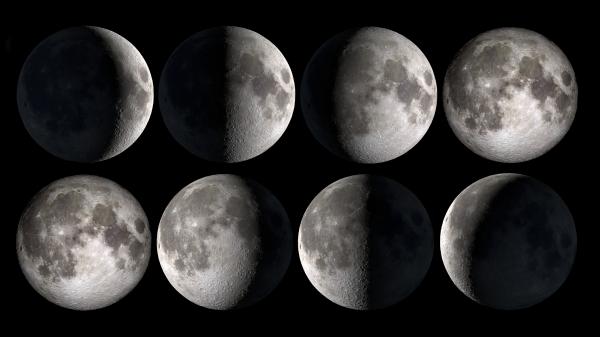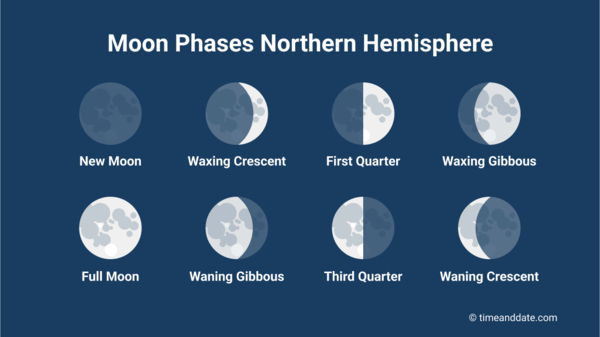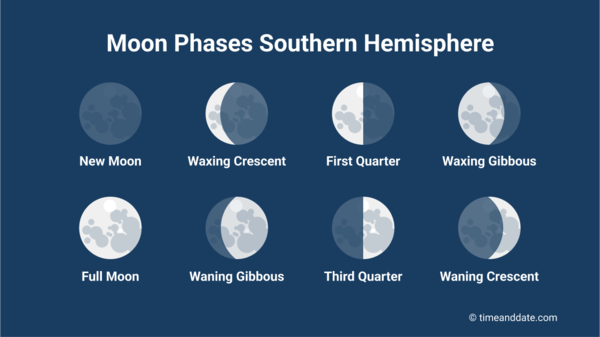The Lunar Month
A lunar month is the time it takes the Moon to pass through all of the Moon phases, usually measured from one New Moon to the next New Moon.

A lunar month starts at the invisible New Moon and lasts through all the Moon phases until the next New Moon.
©bigstockphoto.com/Delpixart
Jan 2025: See the planets at their best
The Crescent Moon, Saturn & Venus align in January 2025
C/2024 G3 (ATLAS): Best comet of 2025?
What Is the Lunar Cycle?
A lunar month is about 29.5 days and is the time it takes the Moon to pass through all of the Moon phases. The exact length varies because the orbit of the Moon is an elliptical (or oval) shape.
©timeanddate.com
Why are Lunar Months Different Lengths?
Because the Moon’s orbit is elliptical, sometimes it is near, and sometimes far from Earth.
The longest lunar month takes place when two New Moons are close to apogee, the Moon’s farthest point from Earth in its orbit.
Oppositely, when the New Moons take place close to perigee, the Moon’s closest point to Earth, the shortest lunar month occurs.
The reason for this is that the Moon travels along its orbit more quickly when it is closer to Earth.
Lunar Calendar 2025
| Lunar Month Start* | Lunar Month End* | Lunar Month Length |
|---|---|---|
| Dec 30 (2024), 22:26 | Jan 29, 12:35 | 29 days, 14 hours, 9 mins |
| Jan 29, 12:35 | Feb 28, 00:44 | 29 days, 12 hours, 9 mins |
| Feb 28, 00:44 | Mar 29, 10:57 | 29 days, 10 hours, 13 mins |
| Mar 29, 10:57 | Apr 27, 19:31 | 29 days, 8 hours, 34 mins |
| Apr 27, 19:31 | May 27, 03:02 | 29 days, 7 hours, 31 mins |
| May 27, 03:02 | Jun 25, 10:31 | 29 days, 7 hours, 29 mins |
| Jun 25, 10:31 | Jul 24, 19:11 | 29 days, 8 hours, 40 mins |
| Jul 24, 19:11 | Aug 23, 06:06 | 29 days, 10 hours, 55 mins |
| Aug 23, 06:06 | Sep 21, 19:54 | 29 days, 13 hours, 48 mins |
| Sep 21, 19:54 | Oct 21, 12:25 | 29 days, 16 hours, 31 mins |
| Oct 21, 12:25 | Nov 20, 06:47 | 29 days, 18 hours, 22 mins |
| Nov 20, 06:47 | Dec 20, 01:43 | 29 days, 18 hours, 56 mins |
| Dec 20, 01:43 | Jan 18 (2026), 19:52 | 29 days, 18 hours, 9 mins |
*New Moon dates and times in UTC.
Note that the shortest lunar months coincide with Super New Moons (Mar 29 and Apr 27) when the Moon is near perigee; conversely, the longest lunar months fall close to the Micro New Moon on Nov 20.
Moon phase times in your location
Phases of the Moon
Half of the Moon’s surface is always illuminated by sunlight. As the Moon orbits Earth, it changes how much of the lit-up side we can see. This is known as a Moon phase. Primary Moon phases happen at a specific moment in time, while the time between these moments are intermediate Moon phases.
The primary phases are New Moon, First Quarter Moon, Full Moon, and Third Quarter Moon.
The intermediate Moon phases are Waxing Crescent Moon, Waxing Gibbous Moon, Waning Gibbous Moon, and Waning Crescent Moon.
Is the Moon upside-down in the other hemisphere?
How Do We Measure a Lunar Month?
A lunar month is generally measured from the precise moment of one primary Moon phase to the moment of the same Moon phase the next lunar month. Normally, this is from one New Moon until the succeeding New Moon.
A lunar month, or a lunar cycle, is also known as a lunation. The astronomical term is a synodic month, from the Greek term synodos, meaning meeting or conjunction.
An average lunar month lasts 29.530575 days or 29 days, 12 hours, 44 minutes, and 2 seconds, a few days short of a calendar month.


The orientation of the illuminated side of the Moon in the Northern Hemisphere. A lunar month is the time it takes the Moon to go through all its phases.
© timeanddate.com
Synodic vs. Sidereal Month
The time it takes the Moon to complete one orbit around Earth is called a sidereal month. Sidereal refers to the Latin word for stars, and sidereal month means that the Moon returns to the same point under the stars. This takes around 27.3 days.
If Earth stood still, the synodic (lunar) month would be the same as the sidereal month. However, at the same time as the Moon is orbiting Earth, our planet continues its annual orbit around the Sun in the same direction. So, after completing a sidereal month, the Moon has to move a little further to catch up to the same alignment with the Sun and Earth as at the previous New Moon. This is why a synodic (lunar) month is around 2.2 days longer than a sidereal month.
The Moon: Our natural satellite
What Is a Lunar Day?
29.5 days is also the length of a solar day on the Moon. For an observer standing on the Moon’s surface, this is the time from one sunrise to the next.
Why is a day on the Moon the same length as a lunar month on Earth? It’s because, like many moons in the solar system, the Moon has synchronous rotation: it takes the same time to spin once on its axis as it does to complete one orbit around the Earth.
Sleep, crime, and menstruation: how Moon phases affect humans
Lunar Calendars
Calendars based solely on the Moon phases are known as lunar calendars, the ones based solely on the Sun are called solar calendars, and the ones that combine the Sun and the Moon are known as lunisolar calendars.
The Islamic calendar is lunar, and also the historic Roman calendar sets the calendar year from the lunar month. The word month is even derived from the word Moon. Ancient cultures also named the Full Moons to track the seasons.
Our Western Gregorian calendar is a solar calendar, and follows the solar year and the Earth’s movements around the Sun. The Persian Solar Hijri calendar starts its new year on the exact time and date of the March equinox, making it one of the most precise calendars in the world.
The lunisolar calendar keeps track of the apparent movements of both the Moon and the Sun. The Chinese, Buddist, and Hindu calendars are lunisolar.


The orientation of the illuminated side of the Moon in the Southern Hemisphere. A lunar month is the time it takes the Moon to go through all its phases.
© timeanddate.com
What Is a Lunation Number?
A lunation number is a number given to each lunar month and is usually found in Moon phase calendars and in almanacs.
The most commonly used lunation number is the Brown lunation number system, invented by Professor Ernest W. Brown in 1933. Brown started lunation 1 with the first New Moon of 1923, and this is why the lunation numbers listed before 1923 are negative, and we are currently in the 1200s today.
There are also other lunation cycles in use, such as Goldstine Lunation Number, Meeus’s Lunation Number, and the Islamic and Hebrew Lunation Number, which counts lunations in the Islamic and Hebrew calendar, respectively.